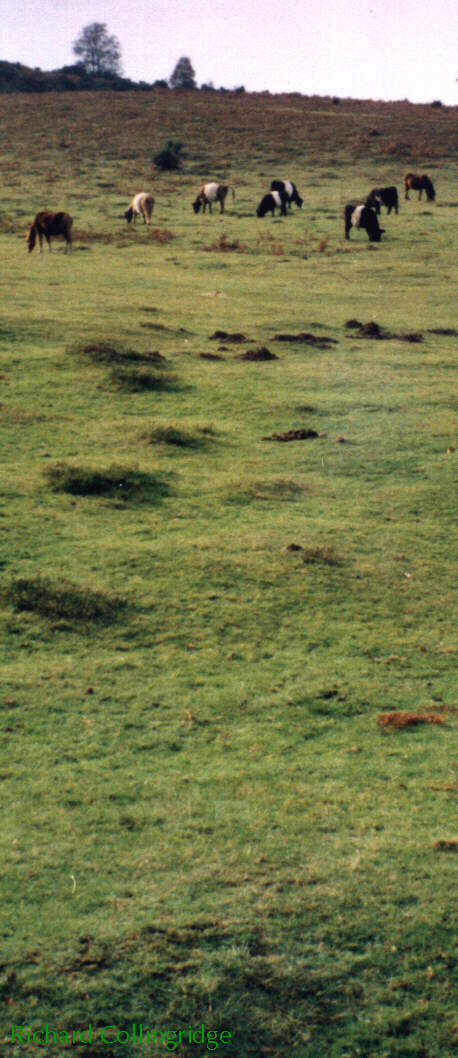Return
to Conservation Information
Contact:
E-mail:
contact@collingridge.net with "contact" in the subject line.
Phone:
+44 (0)1425 475071
Mobile:
+44 (0)7790 677163

The New Forest
Soon after the Norman Conquest in 1066, a large part of south-west Hampshire was declared a royal forest. It has been called the New Forest now for the best part of a thousand years - although it is not new, and in modern language it is not a forest. At that time forest meant land (wooded or not) used for hunting - in fact the Forest was probably hardly more wooded then than it is now - it is mainly open heath, grassland and bog scattered between scrub and denser woodland. There is also some enclosed land, both planted woodland (Inclosures) and systems of small fields around villages and hamlets.
The open unenclosed habitats of the Forest and the commons which border it (such as Rockford Common above) stand out in the lowland British landscape which is now almost all covered in fields, dense woods or urban development. However, in Norman times it would have been much like any other sandy acidic land in the south of England - so in a sense it was not even "new" in the 11th century.
 Much
of the country was then unenclosed, used by local people for grazing their
animals and collecting firewood. Gradually (by means of Inclosure Acts,
mainly around 1800) this common pasture land was enclosed into farmland
and woods with definite boundaries and private owners, leaving common land
restricted to the least fertile areas - fragments wedged between enclosed
land such as farms, woods and towns. Much of the mountain and moorland
of the north and west of Britain is also still common land.
Much
of the country was then unenclosed, used by local people for grazing their
animals and collecting firewood. Gradually (by means of Inclosure Acts,
mainly around 1800) this common pasture land was enclosed into farmland
and woods with definite boundaries and private owners, leaving common land
restricted to the least fertile areas - fragments wedged between enclosed
land such as farms, woods and towns. Much of the mountain and moorland
of the north and west of Britain is also still common land.
Because of their special legal status, the royal forests escaped much of this enclosure, and they retained a lot of the social, economic and ecological structure of the mediaeval landscape. As one of the largest, the New Forest survived better than most. Today it has several hundred commoners, many of whom still exercise their rights to graze their ponies and cattle (and a few sheep and donkeys) and put their pigs out in the autumn to fatten on the acorn crop. The commoners live in villages and hamlets around the edge of and within the Forest, and use small enclosed fields together with their Forest rights to farm in a way which has changed remarkably little over the centuries.
 One
commons right is to put pigs out in the mast season to fatten on acorns
and beech nuts (these young pigs are near Rhinefield). This right is still
called by its Old French name of pannage. Other commons rights have
similar special terms, for example the rights of pasture (grazing), pescary
(fishing), turbary (cutting turf or peat for fuel) and estovers (collecting
fallen timber and small-wood). On most commons the land itself (including
the rights to large timber and minerals) belongs to a separate landowner;
for the New Forest this is the Crown (in practice the Government forestry
body, the Forestry Commission).
One
commons right is to put pigs out in the mast season to fatten on acorns
and beech nuts (these young pigs are near Rhinefield). This right is still
called by its Old French name of pannage. Other commons rights have
similar special terms, for example the rights of pasture (grazing), pescary
(fishing), turbary (cutting turf or peat for fuel) and estovers (collecting
fallen timber and small-wood). On most commons the land itself (including
the rights to large timber and minerals) belongs to a separate landowner;
for the New Forest this is the Crown (in practice the Government forestry
body, the Forestry Commission).
Most lowland commons are no longer grazed, and so they are becoming overgrown with dense scrub and woodland of little ecological or cultural value. The New Forest is a rare exception, and is probably the best surviving example of lowland Britain's ancient working landscape.
Because there is now so little left of the ancient British landscape, many of the habitats and species of the New Forest are rare on a national and even international scale. The Forest has a number of nature conservation designations recognising its value, including SSSI, SPA and candidate SAC. It is soon to be made a National Park.
Richard Collingridge